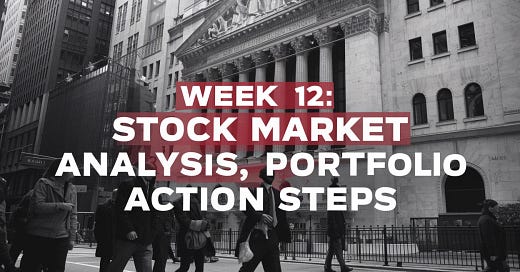Inflation’s clinging on like a stubborn weed, the Fed’s pausing but not exactly smiling, and tariffs keep popping up every time we think we’re done.
Sounds chaotic, right?
In This Week’s Deep Dive:
Macro Overview translated into impact for investors
Defensive vs. Offensive Portfolio Moves you make right now
Concrete Plans for Each Investor Type Depending on Your Goals:
A) Supercharging Future Dividends
B) Getting Bigger Checks Right Away:
C) Spotting Bargain Stocks:
D) Earning Extra Premium with Covered Calls
We’ll first map the macro scene, then talk defense vs. offense, and finally nail down some practical strategies for your exact needs.
1. This Week’s Macro Landscape
1.1 The Fed Holds... but Don’t Call It Dovish
When the Fed chooses not to hike rates again, the crowd typically cheers.
But here’s the catch: The central bank’s updated projections showed (1) a hint more inflation than previously expected, and (2) slower GDP gains for the year.
You might be thinking, “Wait, so if inflation’s still hot, why not keep hiking?”
Possibly because they’re worried about overshooting and strangling the economy.
So the Fed sits on its hands, letting the data “speak.”
Investor Impact:
Dividend Growth Resilience: Firms with stable earnings and moderate payout ratios can weather a rate environment that’s not going down quickly.
Watch the Debt-Heavy: The Fed’s not exactly friendly right now. If inflation lingers, you might see more subtle hikes or fewer cuts, which drive up debt costs. Companies leveraged to their eyeballs could feel a pinch in their dividend plans.
Actionable Tip:
I keep a close eye on monthly inflation numbers (CPI, PCE). If we get two or three “hotter-than-forecast” prints in a row, the Fed might re-accelerate tightening—a scenario that historically smacks cyclical stocks 10-15% while boosting demand for stable dividend payers.
1.2 Tariff Tangles, Round Infinity
So, yes, word on the street is that the U.S. could soon slap a 25% import tax on some big-ticket items, especially from Asia.
At this point, you might say, “I’ve lived through 2018-2019, I know how this ends.”
But trade friction changes shape each time—new industries, new supply-chain choke points, new tactics from trading partners.
Investor Impact:
Margin Watch: Import-reliant companies will likely pay more for components. Some can pass that cost to consumers without much pushback, but not all. That’s where dividends get fragile—when a chunk of free cash flow bleeds away on higher input prices.
Potential Dip-Buys: Some well-run cyclical names may temporarily trade at 10%–20% discounts if the tariff fear gets priced in. If your research says the fundamentals aren’t actually compromised, consider that your open invitation to pick up shares at a discount.
Actionable Tip:
Keep a “tariff watchlist.” If, say, Caterpillar or a key semiconductor stock tumbles just because of a cost pass-through, revisit the numbers. If dividend coverage remains strong (and the payout ratio still comfortably under 60%), you might pounce on the dip.
1.3 The Fragile Consumer
We’ve got some fresh data: Retail sales missed forecasts, and certain consumer sentiment gauges show a worrying tilt to the downside.
The job growth’s still positive but missed the mark a couple of times in a row.
Don’t interpret that as a certain meltdown, but do note that consumer demand is the backbone of the U.S. economy.
If folks get stingy, watch out for restaurants, apparel, travel, and especially big-ticket discretionary items.
Investor Impact:
Softening Guidance: Retailers and hospitality names might guide lower. Dividend coverage in borderline stable companies gets threatened.
Shifting Spending Patterns: Necessity-based goods (groceries, personal care) hold up best in recessions. For instance, consumer-staple dividend payers like Procter & Gamble or Coca-Cola often see share prices hold steady or even rise.
Actionable Tip:
If consumer discretionary names that historically thrive in expansions (cruise lines, upscale retailers, or automotive) see a big volume slowdown, they might cut or freeze dividends. If I hold them, I want to see a strong balance sheet or a proven track record through prior slumps—otherwise, I’m out.
1.4 T-Bills Beckon… Possibly a Canary in the Coal Mine
You’ve seen the news: Certain big funds and respected investors are shoveling billions into 3- to 6-month T-bills yielding around 5%.
My sceptical side says: “Sure, stash your cash in T-bills. Great if you think a correction looms. But if the sky doesn’t fall, you just missed out on some pretty sweet equity returns.”
Investor Impact:
Opportunity Cost: T-bills yield ~5%. So if you’re taking equity risk for, say, a 4% dividend yield, you better be confident about capital appreciation or future dividend growth.
Potential Crash Insurance: In big market drawdowns (think 10%–20%), the short-term T-bill crowd can rotate back into stocks at fire-sale prices.
Actionable Tip:
If you’re nearing or in retirement, a short-term bond ladder might offer decent yield and near-zero volatility. But if you have a longer horizon, keep a chunk in stable dividend stocks that historically bounce back and even raise their payouts during recessions.
2. Defensive vs. Offensive Moves To Consider
In my experience, the best approach is situational.
You want a portion of your portfolio acting as a “safety net” and another portion that actively hunts for undervalued gems.
2.1 Defensive Tactics
Quality Dividend Growth
Companies that have hiked payouts for, say, 10+ consecutive years. They typically survive recessions with minimal scarring.
Look for net-debt-to-EBITDA under 3 if possible. If they can’t handle moderate rates, I don’t want them.
Staples and Utilities
People buy toilet paper and pay their electric bills even in a downturn. That steady revenue stream keeps dividends safer.
Short-Term Ladder
3- to 6-month T-bills or short-duration treasuries. Currently paying ~5%. I use them as my “liquidity pocket,” ready to deploy when a stock I love suddenly tanks.
2.2 Offensive Tactics
Dip-Buying in Reaction to Tariff or Macro Hysteria
I keep a watchlist of 15–20 names. If a quality industrial or chipmaker plunges 15% in two days on tariff news, I look deeper. If the long-term story’s intact, that’s a gift, folks.
Value + Dividend
This is the Buffett-esque approach: finding stable businesses at multiples below their 5-year average. If they pay 3–4% yields while you wait, that’s gravy.
Covered Calls
Perfect for turning a “sideways” stock into a yield generator. Sell calls 5–10% above current prices, pocketing the premium. If the stock rips above your strike, you get your shares called away at a profit. If it stays put, you keep the stock and the premium.
3. Next: Concrete Plays: Depending on Your Goals
A) If Your Goal Is to Supercharge Future Dividends
What You’ll Learn:
How seemingly small yields today can explode into impressive income streams a few years down the road. Which growth metrics actually matter, so you don’t chase companies that fizzle out.
B) If You Want Bigger Checks Right Away
What You’ll Learn:
How to sniff out higher-yield plays that might hold up when interest rates rise or the market sours. Which coverage ratios and debt metrics keep you from falling for “too-good-to-be-true” payouts.
C) If You Love Snapping Up Bargains
What You’ll Learn:
How to distinguish a temporary stock-price meltdown from a genuine “dividend in distress.” Why contrarian buying can lead to major upside—if you’ve done your due diligence.
D) If You Want to Top Off Your Dividend With Covered Calls
What You’ll Learn:
Which stocks work best for generating extra premium without risking big assignment headaches. How to roll calls if your shares approach the strike price.
Up next, I’ll break down each of these strategies in detail, showing exactly how to apply them in the real world.
Keep reading with a 7-day free trial
Subscribe to The Multiplier to keep reading this post and get 7 days of free access to the full post archives.







